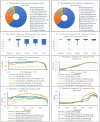The evolving species concepts used for yeasts: from phenotypes and genomes to speciation networks
- PMID: 34720775
- PMCID: PMC8550739
- DOI: 10.1007/s13225-021-00475-9
The evolving species concepts used for yeasts: from phenotypes and genomes to speciation networks
Abstract
Here we review how evolving species concepts have been applied to understand yeast diversity. Initially, a phenotypic species concept was utilized taking into consideration morphological aspects of colonies and cells, and growth profiles. Later the biological species concept was added, which applied data from mating experiments. Biophysical measurements of DNA similarity between isolates were an early measure that became more broadly applied with the advent of sequencing technology, leading to a sequence-based species concept using comparisons of parts of the ribosomal DNA. At present phylogenetic species concepts that employ sequence data of rDNA and other genes are universally applied in fungal taxonomy, including yeasts, because various studies revealed a relatively good correlation between the biological species concept and sequence divergence. The application of genome information is becoming increasingly common, and we strongly recommend the use of complete, rather than draft genomes to improve our understanding of species and their genome and genetic dynamics. Complete genomes allow in-depth comparisons on the evolvability of genomes and, consequently, of the species to which they belong. Hybridization seems a relatively common phenomenon and has been observed in all major fungal lineages that contain yeasts. Note that hybrids may greatly differ in their post-hybridization development. Future in-depth studies, initially using some model species or complexes may shift the traditional species concept as isolated clusters of genetically compatible isolates to a cohesive speciation network in which such clusters are interconnected by genetic processes, such as hybridization.
Keywords: Comparative genomics; Fungi; Hybrids; Nomenclature; Species concepts; Taxonomy.
© The Author(s) 2021, corrected publication 2021.
Conflict of interest statement
Conflict of interestThere is no conflict of interest.
Figures



References
-
- Abbott R, Albach D, Ansell S, Arntzen JW, Baird SJE, Bierne N, Boughman J, Brelsford A, Buerkle CA, Buggs R, Butlin RK, Dieckmann U, Eroukhmanoff F, Grill A, Cahan SH, Hermansen JS, Hewitt G, Hudson AG, Jiggins C, Jones J, Keller B, Marczewski T, Mallet J, Martinez-Rodriguez P, Möst M, Mullen S, Nichols R, Nolte AW, Parisod C, Pfennig K, Rice AM, Ritchie MG, Seifert B, Smadja CM, Stelkens R, Szymura JM, Väinölä R, Wolf JBW, Zinner D. Hybridization and speciation. J Evol Biol. 2013;26:229–246. doi: 10.1111/j.1420-9101.2012.02599.x. - DOI - PubMed
-
- Ahrendt SR, Quandt CA, Ciobanu D, Clum A, Salamov A, Andreopoulos B, Cheng JF, Woyke T, Pelin A, Henrissat B, Reynolds NK, Benny GL, Smith ME, James TY, Grigoriev IV. Leveraging single-cell genomics to expand the fungal tree of life. Nat Microbiol. 2018;3:1417–1428. doi: 10.1038/s41564-018-0261-0. - DOI - PMC - PubMed
-
- Aime MC, Miller A, Aoki T, Bensch K, Cai L, Crous PW, Hawksworth DL, Hyde K, Kirk P, Lücking R, May T, Malosso E, Redhead SA, Rossman A, Stadler M, Thines M, Yurkov Y, Zhang N, Schoch L (2021) How to publish a new fungal species, or name, version 3.0. IMA Fungus 12:11. 10.1186/s43008-021-00063-1 - PMC - PubMed
Publication types
Grants and funding
LinkOut - more resources
Full Text Sources
Molecular Biology Databases
